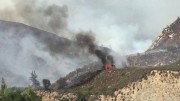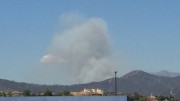Glendora City Staff will unveil Tuesday night an expensive plan to comply with the state’s unprecedented mandatory water conservation measures.
The city’s estimated $6,430,696 urgency ordinance was drafted after the State Water Resources Control Board voted to enact strict water conservation requirements May 5. The CAWRCB plan would force Glendora and 410 other water agencies to reduce consumption by 36 percent between now and February of 2016.
The requirements were adopted in order to achieve a statewide 25 percent aggregate reduction in water usage. Governor Jerry Brown issued Executive Order B-29-15 April 1. It is the first such order of its kind in state history.
Here’s a taste of the city’s plan:
- Glendora will consider an audit of its water bills to determine residential usage (which hovers around 85 percent of total consumption) versus commercial, industrial and institutional.
- Some proposed changes would come to the Rebate Program to provide more incentives for using the turf removal program. Rebates could be extended to the K-12 schools to implement weather-based controls and efficiency sprinklers. Grants of up to $5,000 would be available for schools to develop drought education projects.
- The addition of five staff members to increase compliance checks and address questions and concerns from the public.
- The creation of a landscape project list for city facilities. The city is particularly concerned about the fate of mature trees on city medians. Unde Governor Brown’s executive order, median landscaping is not allowed. The city may either purchase water bags for 31 young median trees as a temporary solution, or install 15,000 linear feet of drip irrigation, which would be costlier. A long-term plan could have artificial turf or drought-tolerant plants installed on all of Glendora’s 44 medians.
- Regarding city parks, the water demand at each park could be offset to make up the difference depending on each park’s water demands and usage, in addition to possibly removing 119,770 square feet of turf, reducing ornamental watering at facilities and low-intensity parks to two days per week.
- All residential customers, inclusive of single-family residences and multi-family units, would reduce their R-GPCD to predetermined amounts between June of 2015 and May of 2016. All non-residential customers with landscapes of 500 square feet or more would reduce their consumption by 25 percent of the same months from 2013; those with less than 500 square feet would reduce their consumption by 10 percent.
- The city manager would be authorized to implement measures to meet the state’s conservation requirements without further action by the city council. All actions would be reported for adoption by resolution.
“This likely will result in all communities significantly cutting back on outdoor watering, particularly ornamental landscapes surrounding homes, institutions, and businesses,” said Felicia Marcus, chair of the State Water Resources Control Board. “This will be a heavy lift for some, but we believe that the regulatory strategy adopted today is doable.”
Water data will be monitored monthly starting in June and will be compared to data from the same months in 2013 to determine if a water agency is on track for meeting conservation requirements, according to Water Board officials in a written statement.
Those agencies found to be out of compliance could be fined up to $10,000 per day. Said agencies could also fine property owners up to $500 per day for water violations.
Residential per capita water usage per day is the primary measurement with how the CAWRCB will gauge compliance.
The R-GPCD from each water suppliers’ service area from July to Sept. of 2014 was used to determine in which of the nine categories a water agency would be placed. During that time, Glendora residents consumed 242 gallons per capita per day, placing the city in tier nine with what the CAWRCB considered some of the biggest water consumers.
City officials have expressed in the past their disagreement with the CASWRCB’s methodology of determining the conservation percentage for water agencies to abide by, stating that the new requirements ignore past conservation goals over the last seven years.
Glendora also argues the CAWRCB uses a “more volatile measurement time period” with a 30-day model as opposed to a 12-month model when taking weather patterns into consideration.
California is in year four of an intense drought, with as much as 44 percent of the state experiencing an “exceptional drought.” As of April 8, Statewide snowpack levels, one of the chief sources of water in California, is just 8 percent of the average, according to the Energy Information Administration.
The urgency ordinance will be discussed in greater detail at the City Council meeting, scheduled for Tuesday, May 26 at 7 p.m. in the City Council Chambers, 116 E. Foothill Blvd.






